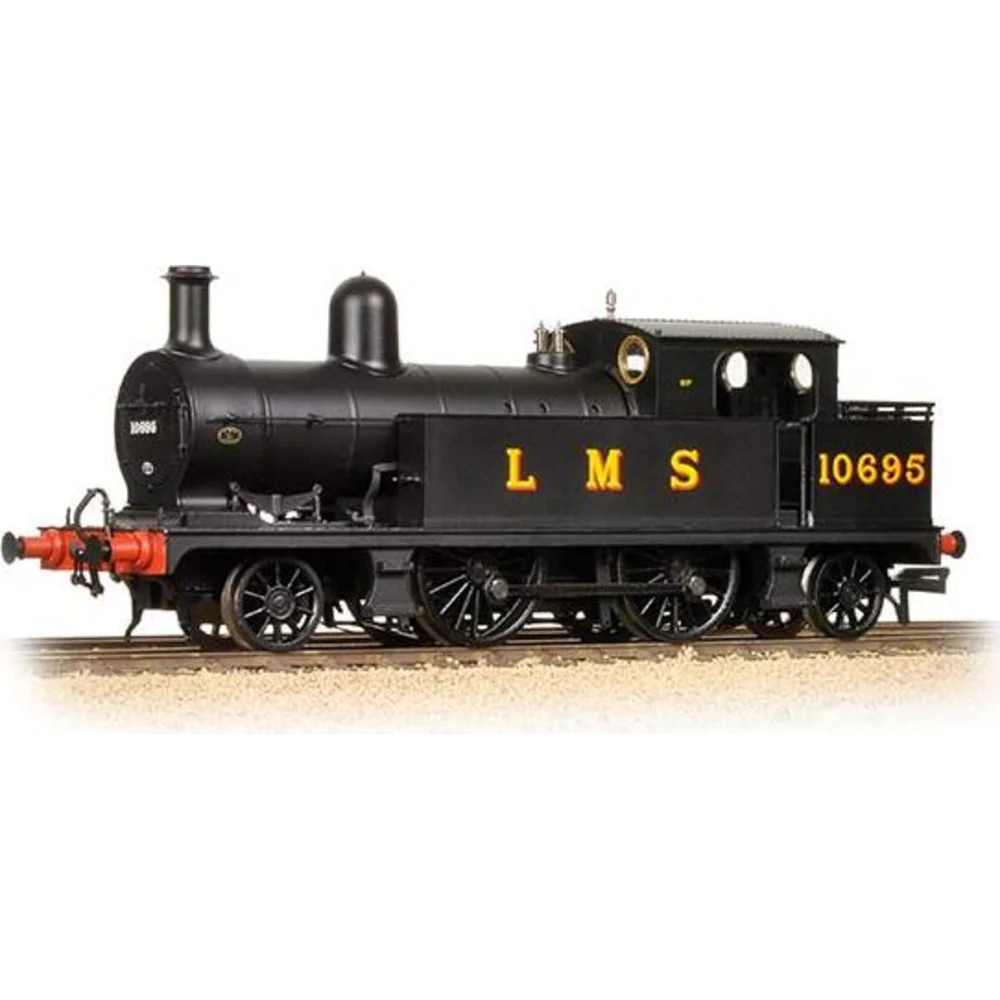Bachmann 31-165
Lancashire & Yorkshire Railway Class 5 10695 London, Midland & Scottish Railway Black
Tooling
In 2013, Bachmann Branchline unveiled its OO gauge model of the Lancashire & Yorkshire Railway Class 5 2-4-2T Radial Tank, designed by J.A.F. Aspinall. This class was a mainstay of suburban and branch passenger services from 1889 onwards, with over 300 locomotives built at Horwich Works. The prototype is notable for being the only British standard-gauge 2-4-2 tank engine preserved—No. 1008, now at the National Railway Museum. Bachmann’s release filled a significant gap in pre-grouping and LMS-era modelling, offering enthusiasts an accurate representation of this iconic radial tank.
Tooling Features
- Scale: OO gauge (1:76)
- Construction: Plastic bodyshell with metal chassis for strength and weight
- Detailing: Separately fitted handrails, lamp irons, coal rails, brass safety valves, smokebox door dart, whistle, bufferbeam detailing, fully detailed cab interior with painted gauges and glazing, pre-fitted pipework, brake rigging, and fluted connecting rods with chemically blackened finish
- Couplings: NEM pockets with tension-lock couplers
Mechanical & Electrical
- Motor: 3-pole motor located in the locomotive body
- Drive: Loco-driven wheels with pickups on all axles for smooth running
- Minimum Radius: Second radius (approx. 450 mm)
- Weighting: Built into the boiler for improved adhesion
- Lighting: None provided
DCC Capability
DCC Ready with a 6-pin socket located in the bunker. Decoder installation requires removal of the blanking plate. No factory sound provision, but aftermarket sound fitting is possible.
Liveries Produced
The tooling has supported a wide range of liveries across multiple eras:
- L&YR lined black (including NRM Special Edition of No. 1008)
- LMS black and LMS crimson lake (1923–1947)
- BR black with early emblem and British Railways lettering (1948–1957)
Weathered and DCC-fitted variants have also been offered.
Reviews & Commentary
The model has received strong praise for its fine detailing, cab interior finish, and smooth running:
- Sam’s Trains Review – Highlights diecast chassis, crisp lining, and reliable mechanism
- Class47Peter Running Session – Commends intricate rivet detail and accurate cab fittings
Social media and forums note its appeal to pre-grouping modellers and versatility for LMS and BR layouts.
Interesting Facts
- The prototype featured a water scoop system—unusual for a tank engine—allowing water pickup from troughs without stopping.
- Bachmann’s choice of No. 1008 for the NRM edition reflects its historical significance as the first Horwich-built locomotive and sole survivor of the class.
Class & Prototype
- Class: Lancashire & Yorkshire Railway Class 5
- Traction: Steam
- Built: 1889-1910
- Total Built: 330
- Running Number: 10695
The Lancashire and Yorkshire Railway Class 5 comprises John Aspinall's innovative 2-4-2T radial tank locomotives built at Horwich Works between 1889-1911. Three hundred and thirty examples dominated L&Y suburban services, working 70% of all passenger mileage by 1912 across Lancashire and Yorkshire's intensive industrial railway network. Featuring Webb's distinctive radial trailing truck and Joy valve gear, these locomotives served for 72 years through L&Y, LMS, and BR eras until final withdrawal in October 1961. Only No. 1008—the first locomotive built at Horwich Works in February 1889—survives at the National Railway Museum, now on loan to Bury Transport Museum. Bachmann's 2013 OO gauge models (now discontinued, available second-hand £76-£120+) offered ten variants across L&Y lined black, LMS black/crimson, and BR lined black liveries with exceptional detail including visible radial truck and Joy valve gear.
Operator & Livery
- Operator: London, Midland & Scottish Railway
- Livery: Black
- Era: 3 - The big 4 – LMS, GWR, LNER & SR
The London, Midland & Scottish Railway (LMS) was Britain's largest railway company from 1923-1948, formed by merging over 120 independent railways under the Railways Act 1921. Operating 7,790 route miles across England, Scotland, Wales, and Northern Ireland, the LMS became the world's largest transport organisation and the British Empire's biggest commercial enterprise. Famous for iconic locomotives like the streamlined Princess Coronation class, versatile Black Fives, and Royal Scots, the company evolved from inherited pre-grouping designs to revolutionary Stanier innovations. The LMS operated major routes including the West Coast Main Line from London Euston to Scotland, serving as the UK's second-largest employer after the Post Office. Nationalised in 1948 to form British Railways' London Midland Region, the LMS legacy continues through extensive preservation efforts and remains a favourite subject for railway modellers seeking authentic British steam-age prototypes.
The LMS plain black livery served as the standard finish for freight locomotives and represented practical railway economics during the company's existence. Applied without lining or embellishment, this utilitarian scheme recognised that goods engines operated in inherently dirty conditions where elaborate paintwork proved both expensive and impractical.
Most LMS freight classes including the ubiquitous 0-6-0 goods engines, 0-8-0 heavy freight locomotives, and tank engines used for shunting duties wore plain black throughout their service lives. The scheme extended beyond locomotives to goods wagons, where black paint provided adequate weather protection at minimal cost.
During World War II, plain black became increasingly common as material shortages and wartime economies forced the abandonment of more elaborate liveries. Even some passenger locomotives temporarily adopted unlined black finishes when crimson lake supplies became unavailable. The practical benefits of black paint - its ability to hide dirt, soot, and industrial grime - made it ideal for locomotives working coal trains, mineral traffic, and heavy industrial duties.
For modellers, plain black represents the workhorse reality of LMS operations, particularly appropriate for freight yards, colliery branches, and industrial settings where authentic weathering and operational realism take precedence over passenger train glamour.
